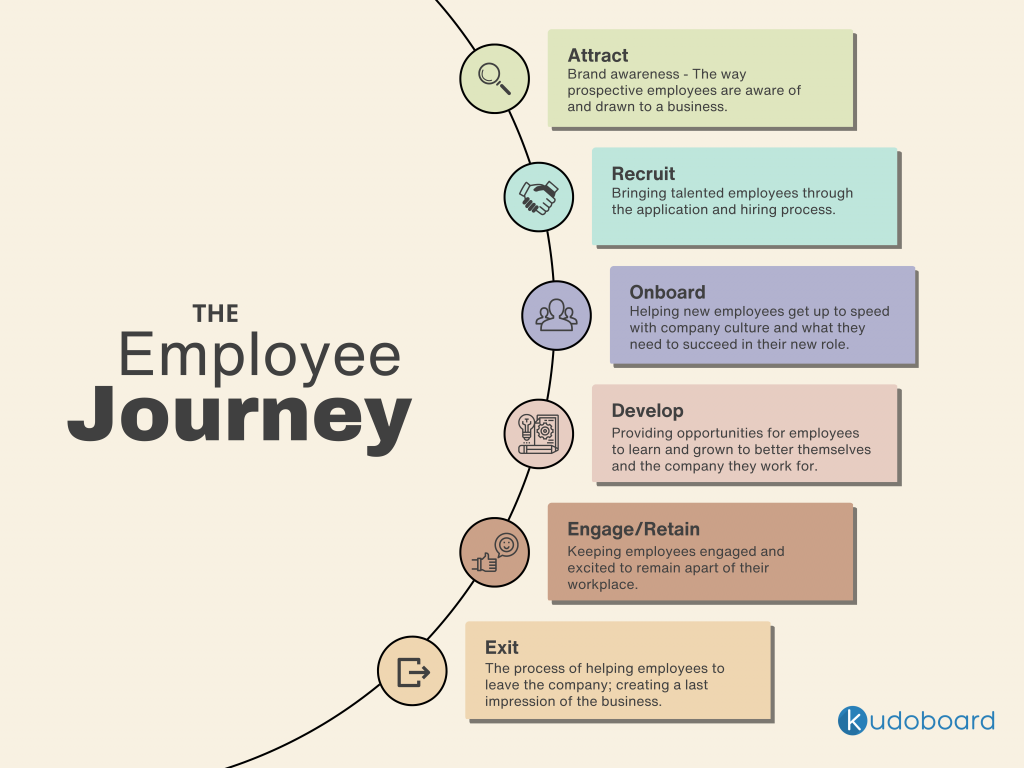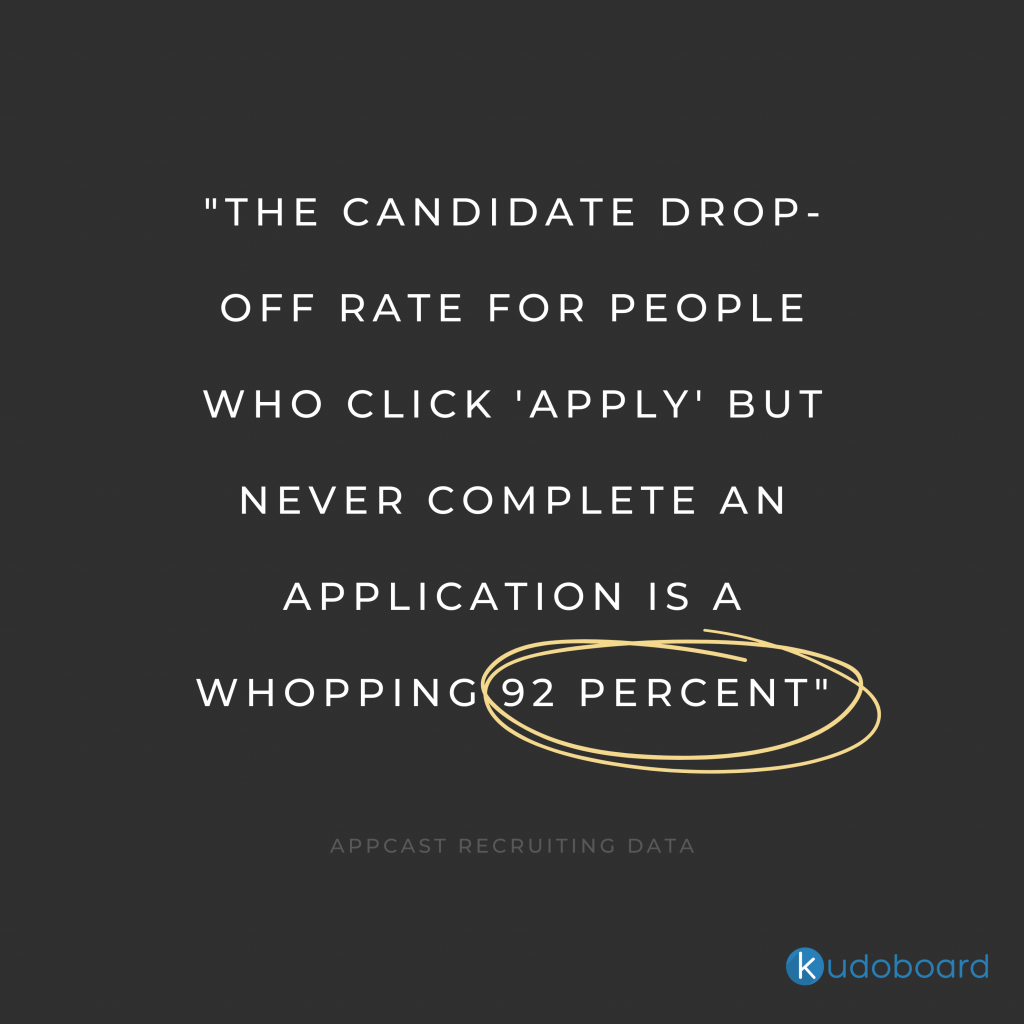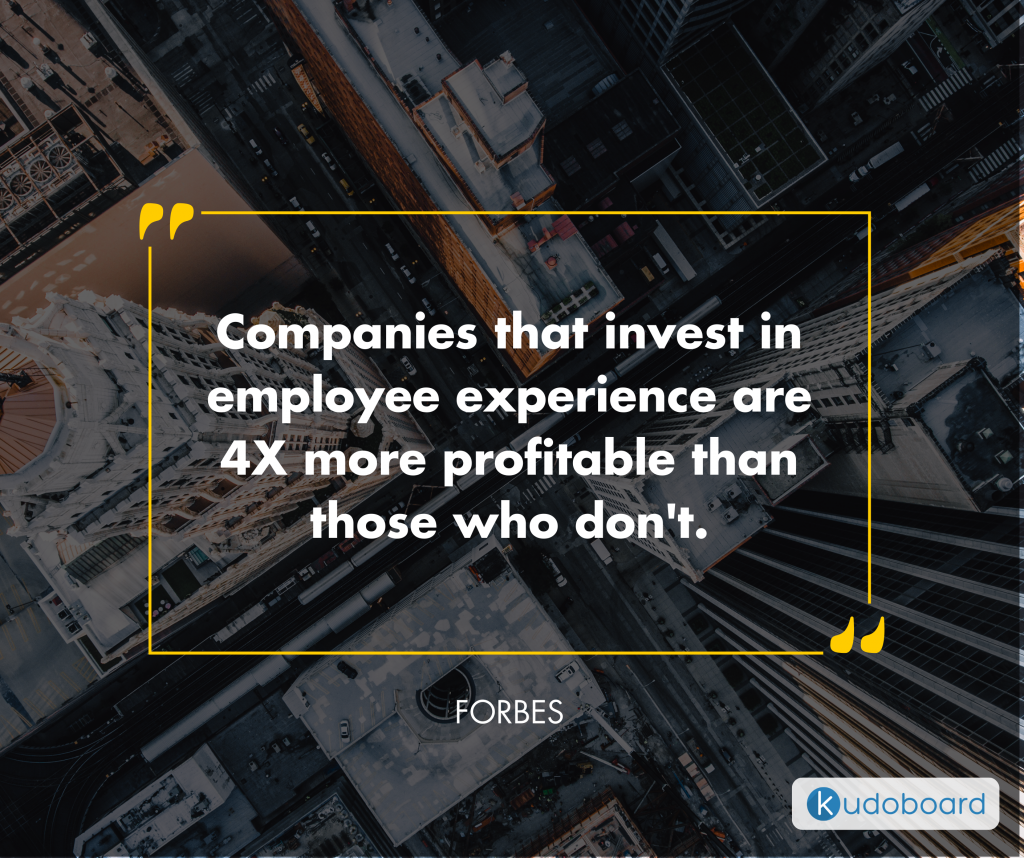Take a look around at the job market today – does it look anything like what you expected 10 years ago? Probably not. Rapidly changing social media influences, the fight to retain committed and talented employees, hybrid and remote workplace shifts, and Gen Z’s changes in job expectations – each of these, and many more, are everchanging and keeping company leaders on their toes. The previous circumstances we once thought were here to stay are sifting through our fingers like sand at the beach, and it’s leaving companies scrambling to keep up. The value of a loyal and engaged employee hasn’t changed, but the way to retain those employees certainly has. Just like we all know the importance of a positive customer experience, we also are seeing the need to invest in the employee experience as well.
Today, more than ever before, it is vital to the success of a business to build a foundation out of employees who feel like their job is enhancing their quality of life rather than draining it. A positive employee experience is the best way to make that happen.

What is Employee Experience?
The term “employee experience” (sometimes referred to as EX) has increased in popularity over the last few years, referring to the culmination of everything an employee hears, sees, feels, and does throughout their time at a job. An employer might default to seeing each area of their company as a separate piece; Items on a checklist to manage and oversee. Human resources, bonuses, onboarding, payroll – from high up the company chain, each present something different to be dealt with. To an employee, however, each aspect of a business blends into one picture that affects how they feel about their experience as a whole. Realizing this fact helps employers to adjust their approach so that their company culture can provide an overall employee experience that leaves a good taste in peoples’ mouths.
Employee experience is a way to explain the comprehensive birds-eye view of each piece that makes up an employee’s journey through a company, from beginning to end. Throughout their time in any given workplace, each employee will encounter (for worse or for better) checkpoints along the way. These checkpoints, otherwise known as the employee lifecycle or the employee journey, help to explain this shared experience among all employees. Each stage of the employee lifecycle plays an integral part in determining whether an employee’s journey through a company is a positive or negative one.
The Employee Journey
The employee journey provides a map to navigate a path to understanding the employee experience. Each employee’s journey moves through six stages: attraction, recruitment, onboarding, development, engagement or retainment, and exit. Each of these six steps together creates the pulse of the employee experience, and highlighting them in a business’s employee experience strategy allows them to identify their strengths and weaknesses and find ways to improve where needed.

- Attraction
This step is the first impression of company culture given to prospective employees, whether or not they eventually get hired. Attracting talent to a business is directly linked to brand awareness and public perception of that company. It’s been shown that individuals are less likely to apply for a job with a bad public image, and 75% of Americans looking for a job are more likely to apply to a business that is actively managing its employer brand.
“69% of Americans would not take a job with a company that had a bad reputation, even if they were unemployed”
Placing importance on this step helps to lower the amount of money a business will have to spend on attracting employees because individuals will seek them out, rather than the other way around. The experience job seekers have in this step, regardless of if they move on to being hired, will affect the way they speak to others about that company, which then in turn shapes the company brand.
- Recruitment
This stage is often paired together with the first, or presented as the same because much of what they deal with overlaps. They both focus on finding talented people and then initiating the hiring process. Once a job seeker’s interest has been piqued in the attraction step, they enter the fragile state of recruitment. Everything about the company, from the way their application process looks and feels, to the reviews about them online from other employees, will heavily shape whether or not someone moves forward with the application process. The company is suddenly under a microscopic lens to be analyzed by the prospective employee. Aspects that affect their opinions include:
- Job Listings: Their visual appeal, types of phrasing and word choice, how they spell out requirements and expectations, and displays of inclusivity matter a great deal to those looking for jobs.
- Applications: The amount of time and effort it takes to access and complete an application greatly affects the number of completed applications a company receives. According to recruitment data, the more steps and clicks required to get to the end, the less likely someone is to finish.

- Honesty from Employers – When an applicant feels a sense of transparency from an employer it is easier for both sides to communicate effectively what they want and need. To have a positive employee experience there needs to be honesty regarding what to expect in the recruiting and hiring process, what the company culture is like, and what kind of compensation and benefits will be provided. If employers are upfront and honest from the beginning it can save both sides a lot of time and simultaneously leave a good impression on the applicant’s side of things.
- Onboarding
Onboarding gives focused attention to bringing new employees into the company and doing everything possible to make them feel a part of the team. This is where HR leaders set their new hires up to succeed in a work environment by helping them clearly understand their role within the company, defining what “success” looks like within that role, and showing what goals and values are a part of the company culture. Making a new employee feel comfortable with something like a “welcome to the team” card full of messages from coworkers can start things off on the right foot.
Harvard Business Review shared that the onboarding process can make or break the employee experience. A company with substandard onboarding can result in diminished engagement, lowered confidence, and a greater likelihood of employees leaving if they come across an attractive alternative position. If, however, a company has a strong onboarding system in place, employees “are almost three times as likely to feel prepared and supported in their role, boosting their confidence and improving their ability to perform their role well.”
“Only 12 percent of employees feel their company does a good job onboarding new team members.”
GALLOP
In recent years, especially during the Covid-19 pandemic, the shift to virtual workplaces has skyrocketed, presenting businesses with the challenge of how to approach the employee lifecycle beneficially. But even in hybrid or remote workplaces, there are ways to effectively onboard new employees virtually, create a strong company culture, and set employees up to succeed and grow. This plays a large part in seeing higher engagement, greater employee satisfaction, and higher employee retention rates.
Read More: 5 Principles of a Good Virtual Onboarding Session For New Employees
- Development
In a study of roughly 34,000 exit interviews, 21 percent of those leaving a company stated their reason for going elsewhere was a lack of growth and development within their career. Employees want to spend their time in a job that provides opportunities to learn and grow (can you blame them?). This is where the development stage of the employee journey comes in. Development is not an item to check off a list, but rather an ongoing cycle of presenting the chance to learn new skills, improve on current ones, and illustrate a path toward growth.
Internal communication in this step is key to employee satisfaction in the areas of growth being offered. Each employee is unique in what they have to offer and what they hope to gain while employed. Listening to what employees have to say can help steer things in the right direction.
- Engage and Retain
“The great resignation” tidal wave hitting the business world is demanding something for us to see: employees are not happy with their jobs. The fact that over 4 million Americans quit their job in July of 2021, and roughly 20 percent of Americans planned to quit their job in 2022, doesn’t bring peace of mind when trying to hold on to talented and productive employees. This stage of the employee life cycle for leaders is less of a “step to climb” and more of a “path to continually walk.”
Employee turnover is costly to both workplace morale and the money spent by a company, particularly regrettable attrition. Depending on the employee’s position, losing and replacing a worker can cost between 50-125 percent of their yearly salary – and that number doesn’t even consider the emotional cost of employees left behind who burn out under heavier workloads.
This leads to the need for focused attention on this stage of the employee journey. Maintaining engagement among current employees through a variety of strategies is a key aspect of a positive employee experience.
Read More: Why Employee Retention Matters
- Exit
The last step of the employee journey deals with the way employees leave a company. They leave for many different reasons – retirement, better job opportunities, layoffs, life changes, etc. This stage is important because it is the last impression an employee has of a company which will complete the “employee experience” picture. How an employee separates from their job will affect the way they speak about the company to others, which cycles us back around to the attraction and recruitment of future employees. This step can provide invaluable information through employee feedback to improve the employee experience strategy. To help employees exit on a good note, a thoughtful process laid out for offboarding is necessary. Businesses that are strong in this area utilize strategies like:
- Effective exit interviews to gather feedback on how their employees are perceiving their job environment. Asking the right questions will determine whether or not this strategy is helpful.
- Providing resources and guidance in finding another job in situations like firings or layoffs.
- Sending a gift or thank you note giving personalized reasons why someone made an impact during their time employed.
- Keeping in contact as an employee moves on to other jobs or life adventures.
Each of these strategies will increase the likelihood of past employees referring talented friends or family or even rejoining the company sometime in the future.
Why is the Employee Experience Important?

Covering the steps of the employee journey is necessary to understand, but it is only part of the equation. Employers also need to recognize how attention to the employee experience will directly affect the company’s day-to-day life. Providing a great employee experience is tied to the customer experience, engagement among employees, productivity and performance, and overall company culture.
Customer Experience
The customer experience has long been seen as a crucial aspect of success in a business. However, many agree that in order to have a positive customer experience, it is necessary to first create a positive employee experience. It isn’t difficult to see how happier employees would create a better experience for customers. Research from Glassdoor proves that there is a strong correlation between the two.
“On average, a 1-point increase in Glassdoor company rating is associated with a 1.3-point increase in customer satisfaction”
Customers are smart, and they can tell if an employee enjoys their jobs, as it will seep into the way employees speak about the company, interact with customers, and present or sell products. If customers have a better experience with a company they will be more likely to recommend them to others, which in turn will strongly correlate with the company’s reputation. Better employee experience = better customer experience = better business overall.
Workplace Engagement
While the employee experience looks holistically at everything impacting job perception, workplace engagement differs by focusing more on the positive feelings that lead employees to feel committed and engaged in their roles. Gallup’s definition of engagement in the workplace is “those who are involved in, enthusiastic about, and committed to their work and workplace.” Engagement at work tends to create more employee satisfaction, greater motivation, better collaboration and communication, and stronger employee retention rates.
“Happy workers are less likely to burn out, be absent from work, or quit their jobs, and tend to earn slightly higher incomes”
Psychology Today
Performance and Productivity
Engagement in a workplace is directly tied to a company’s performance and productivity. It’s shown that if a company has employees who are highly engaged they will outperform competitors by 147 percent. When employees feel good about their experience at their job, they do better all around. This inevitably leads to increased productivity which means better profits for the company. Happy employees are less likely to leave their jobs, therefore lowering turnover rates. When they aren’t stressed, overworked, or worried about things like potential layoffs, they are more likely to access their own valuable creativity and innovation. Both the company and its employees benefit from an environment where employees can take risks and try new things,

Company Culture
Company culture is defined as “a shared set of goals, practices, and general attitude of the company.” An employee’s experience with company culture undoubtedly influences the way they interact in and out of work. A strong and defined work culture raises productivity, boosts morale, benefits the brand and reputation, and encourages better communication and collaboration. The employee experience is increased for everyone when companies show that they value employee feedback, provide recognition and rewards, prioritize mental and physical well-being, encourage learning and growth, and increase company-wide diversity and inclusion.
“Organizations that invest in employee experience are up to 40x more likely to be on other ‘best-of’ lists like ‘best places to work,’ ‘most innovative companies,’ ‘best work-life balance,’ and more.”
Jacob Morgan
Read More: What is Company Culture?
How to Create a Positive Employee Experience
You understand why it is important to create a positive employee experience, but how do you make it happen? Your employee experience management is not going to create happy employees overnight, but committing to small steps in the right direction will make a big difference. There isn’t a “one size fits all” solution, which means you will have to research which options are right for your company and employees. Consider the following 5 ideas to create a more positive experience when designing an employee experience strategy:
- Listen to employee feedback: Whether you have one-on-one conversations or utilize various surveys, pay attention to what employees are saying and take note of any recurring themes. This will highlight areas that need improvement.
- Take measurements: It’s hard to know if you are on the right track if you don’t have any data to look at. Tracking various employee experience metrics can help gauge when you are at. Consider using things like regular pulse surveys, or the classic net promotor score to get you started. Implementing stay interviews is another helpful strategy to gather important information.
“If you can’t measure something, you can’t understand it. And if you can’t understand it, you can’t improve it.”
Dan Ryan – CEO of VergeSense
- Consider hiring an onboarding specialist: As a member of human resources, an onboarding specialist’s focus is to help new hires start with a strong foundation and feel like their success is a priority. An effective onboarding process improves employee retention rate by 82% and productivity levels by 70%.
- Show workplace appreciation: Finding ways to ensure employees feel valued, recognized, and appreciated greatly affects the employee experience. Employees are more motivated to stay and engage in a job where they know their contribution is valued. Workplace appreciation comes in many forms which allows you to customize ideas for your business and employees. A Kudoboard online group greeting card for things like birthdays, work anniversaries, or shout out’s is an easy and inexpensive way to make a significant impact.
Read More: Does Workplace Appreciation Actually Work?

- Prioritize employee wellbeing: Your employees will thrive in a setting that fosters good mental and physical health. Actively promoting team wellness and implementing things like flexible work arrangements, better work-life balance, access to more physical activity, and easy access to mental health supports are great places to start.
Conclusion
There is a shift happening regarding who holds the power in the work environment. Where it has previously been solely the employers who call the shots, things are slowly tipping into the employees’ hands. The employees are making it clear that they do not have to stay in a job that is negatively affecting their lives. If companies want to attract new employees and retain the ones they currently have, they will have to place a greater focus on how their employees feel about their work environment. Now is the time to get ahead of the game and prioritize the employee experience.
“In a world where money is no longer the primary motivating factor for employees, focusing on the employee experience is the most promising competitive advantage that organizations can create. So the question is, what is your organization doing to improve the employee experience?”
Jacob Morgan





